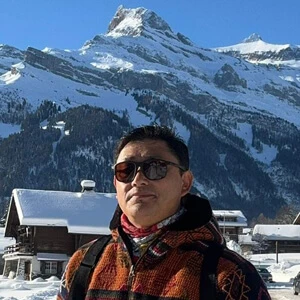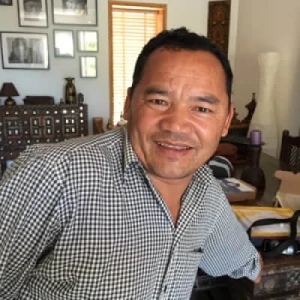Saribung Peak climbing is one of the greatest adventures in Nepal. It is a beginner-friendly trekking peak that stands 6,328 meters (20,761 ft) above sea level. Climbing this peak allows you to explore the gem of the western Himalayas, the Upper Mustang, the holy Damodar Lake, and the exclusive Nar Phu Valley.
On the Saribung Peak climbing 24 days, you will travel far northwest in the complete wilderness that is rarely visited by trekkers. The journey will present you jaw-dropping views of the Annapurna and Dhaulagiri ranges along with other mountains like Nilgiri, Fishtail, Damodar Himal, Bhrikuti Himal, etc.
You will begin the journey from Kathmandu, Nepal. Travel to Pokhara and take a scenic short flight to Jomsom. From here, you will start trekking to Lo Manthang, the last forbidden kingdom in Nepal. It will take you five days to walk to Lo Manthang from Jomsom.
The trekking part is essential to acclimatization and avoiding altitude sickness during climbing. We also have an acclimatization day at Lo Manthang. You will then trek via the remotest corners of Upper Mustang, like Yara, Luri Gompa, Gyuma Thanti, and Namta Khola, to reach Damodar Lake.
Enjoy the serenity of this isolated lake, then climb to Saribung Peak Base Camp the next day. The following day, ascend to Saribung Peak High Camp and wait for the perfect summit window. On the way, you will cross the Saribung Pass and climb to the top. Return to base camp and descend to Phedi the day you summit Saribung Peak.
From Phedi, you will traverse the Nar Phu Valley. The trail descends to Nagoru from Phedi. From here, you will trek to Phu Gaon. We are not trekking to Nar Gaon, but you can extend your trip by 1-2 days. Follow a sharp downhill trail from Phu Gaon to Meta and descend to Jagat via Koto, where the walking part ends.
You will drive back from Jagat to Kathmandu via Besisahar. It will be a comfortable and scenic ride. We have left one free day in Kathmandu, which allows you to rest and shop before flying home the next day.
Altitude Sickness
The Saribung Peak climbing expedition will take you up to 6,328 meters above sea level. Although you will not spend over 20 minutes at this height, you will be exposed to a very high elevation. So, you have to be acclimatized before you go above 5,000 meters.
We have designed our Saribung Peak climbing itinerary to allow you to adjust to the elevation before you reach Saribung Peak Base Camp, located at 5,250 meters (17,224 ft).
You will spend 11 days trekking before reaching the base camp. During this duration, we will gradually expose you to varying elevations and also spend an acclimatization day in Lo Manthang.
From the Saribung Peak Base Camp, you will reach the summit and return in just two days. The elevation gain will be drastic in these two days, but you will be able to handle it. If you experience altitude sickness, our guide will help you treat it.
- Symptoms: Headache, vomiting, nausea, dizziness, insomnia, difficulty breathing, loss of appetite, etc.
- Preventive measures: Ascend slowly, maintain your pace, drink at least 2 liters of water and other fluids a day, get ample rest, eat carbohydrate-rich food to keep up with your energy, and enjoy the trek.
Sherpa guide and porters
The team leader will be the Sherpa guide. You will follow in his footsteps to reach the top of Saribung Peak. He is responsible for the group's safety, so we request our guests to follow his instructions while climbing.
We will provide you with an experienced Sherpa guide who has climbed Saribung Peak many times before. There will be no communication gap as all of our on-field crew can speak English. The guide will provide pre-climbing training before the summit push to boost your confidence.
Porters carry duffel bags and take care of base camp and high camp chores like setting tents and cooking food. They work behind the scenes, making the journey hassle-free for you.
*Note: *Note: Your guide and porter play a huge role in the success and satisfaction of your Saribung Peak expedition. So, we highly recommend that you tip them generously for their hard work. Tipping guides and porters are a well-appreciated part of Nepal's culture.
Climbing experience and preparation for Saribung Peak
Saribung Peak is for beginner climbers, so you do not necessarily need previous climbing experience. However, knowledge of climbing will definitely make the journey more manageable for you.
Saribung Peak is not a technical mountain, but the physical and mental demands are extensive. You have to do treks like Everest Three Passes, Kanchenjunga Circuit, Manasu Circuit, etc. Previous high-altitude experience and exposure to the Himalayan trail are required.
Preparation for peak climbing in the Himalayas depends on your fitness, past experiences, and health. You have to be in optimal physical and mental condition. Strong strength, stamina, endurance, resilience, and willpower are necessary.
Strength training to build your core, aerobic experience to improve your stamina and oxygen intake, yoga for flexibility, balance, breathing, and regular walks are recommended. Make a routine and make yourself strong.
Pre-climbing training: boost your confidence and hone your climbing skills
Pre-climbing training is one of the major perks climbers get with us. At the Saribung Peak Base Camp, your team leader will teach you basic climbing skills and make you aware of mountaineering terms.
The training will make you mountain smart and boost your confidence. You will also learn about the Saribung Peak summit route and how you are going to approach it.
Climbing emergency and evacuation
Climbing in the Himalayas is risky. It is a fact. But, when you travel with experienced Sherpa guides who have summited the mountains several times before and firsthand experienced all the possible odds, the journey suddenly becomes much safer.
We have tested emergency and evacuation protocols that guarantee your safe return to Kathmandu. Our risks are well calculated, and we will not do anything that may jeopardize your safety. Our crew and guests' safety is our top priority during peak climbing.
During your trip, our rescue team is on standby. We regularly check the weather and update the team leader via satellite phone. The climbing routes are fixed with ropes, and you will learn everything required for a successful summit.
In an emergency, the team leader will inform us, and we will take quick action accordingly. If required, the rescue team will reach your location promptly. With us, you are traveling safely in the Himalayas.
Highlights
- Embark on one of the greatest adventures in Nepal
- A non-technical peak, perfect for beginner climbers
- Explore the beauty of Upper Mustang, hike to the holy Damodar Lake, and visit Nar Phu Valley
- Get pre-climbing training from our Sherpa guide and hone your climbing skills
- Witness stunning landscapes and jaw-dropping mountain vistas
- Explore many ancient monasteries, stupas, sky caves, and other Himalayan landmarks
- Reach the summit of Saribung Peak and unlock a huge achievement
Why climb Saribung Peak with the Himalayak Trekking?
We have already discussed our on-field crew and emergency protocol. Now, let's discuss the services and experiences that make us a perfect peak climbing partner in Nepal. We have been mapping the Himalayas and climbing peaks for several years now.
Our team has firsthand experience on Saribung Peak and all other major trekking peaks. Our safety plan, support, and team increase the success rate of the summit. You will get full board service at the base camp and high camp.
Everything will be arranged according to your liking and top Alpine standards. There will be no lack of quality of service. Likewise, you will get the best Saribung Peak climbing cost with us. The bookings are open for Saribung Peak climbing 2024/205 departures.





